Having been top of his bucket list for some time, our destination specialist Max was understandably excited when we asked him to visit the historic city of Evora…
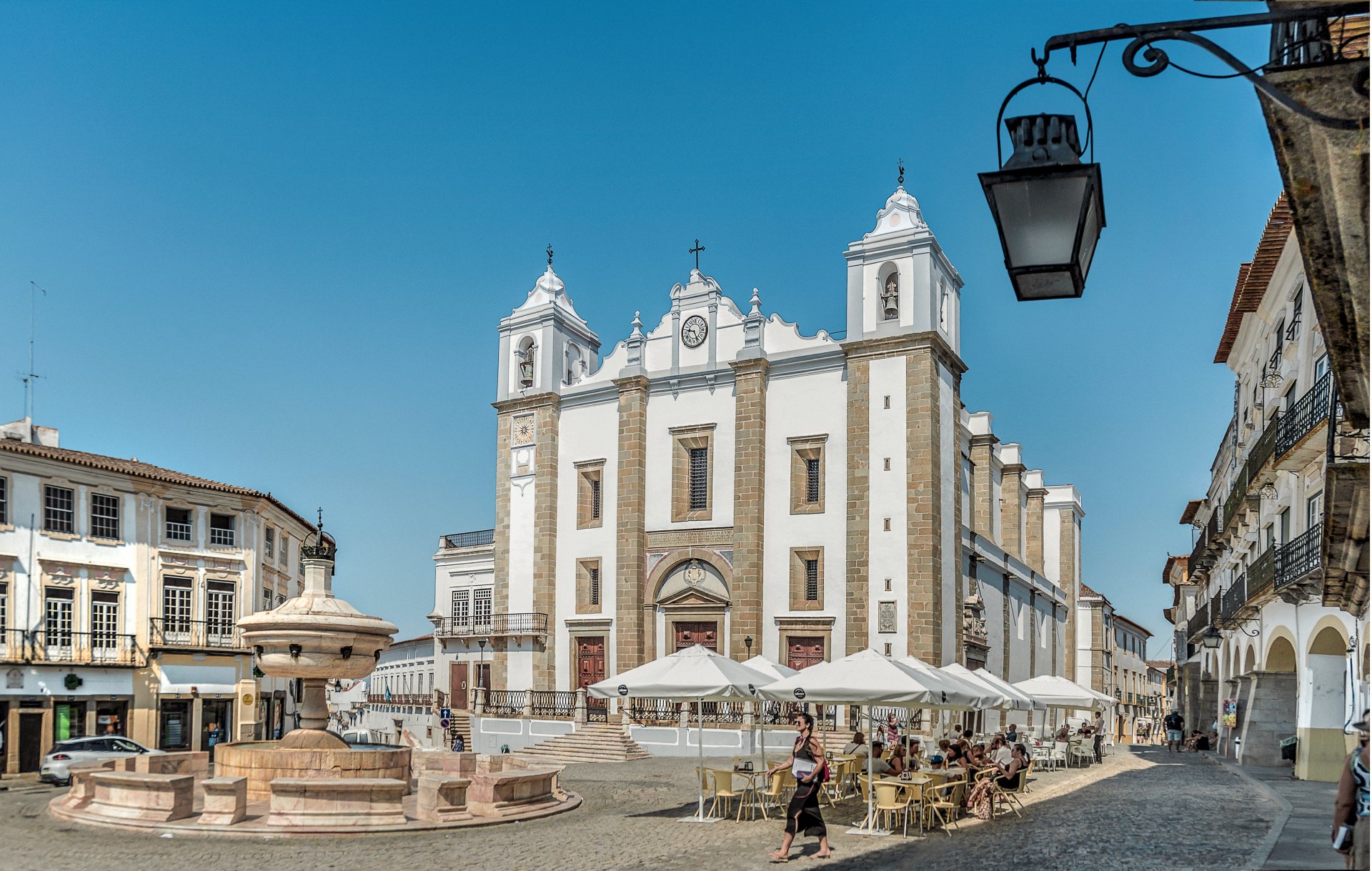 Evora is the capital of Portugal’s Alentejo region and sits east of the capital Lisbon (around a ninety-minute drive/train ride away). As a UNESCO World Heritage Site, it’s a living museum whose beautiful patchwork architecture reflects the history of Portugal itself. The Romans, the Moors and the Portuguese themselves have all made their mark on the city’s impressive churches and palaces, and her robust medieval city walls escaped the great 1755 earthquake unscathed.
Evora is the capital of Portugal’s Alentejo region and sits east of the capital Lisbon (around a ninety-minute drive/train ride away). As a UNESCO World Heritage Site, it’s a living museum whose beautiful patchwork architecture reflects the history of Portugal itself. The Romans, the Moors and the Portuguese themselves have all made their mark on the city’s impressive churches and palaces, and her robust medieval city walls escaped the great 1755 earthquake unscathed.
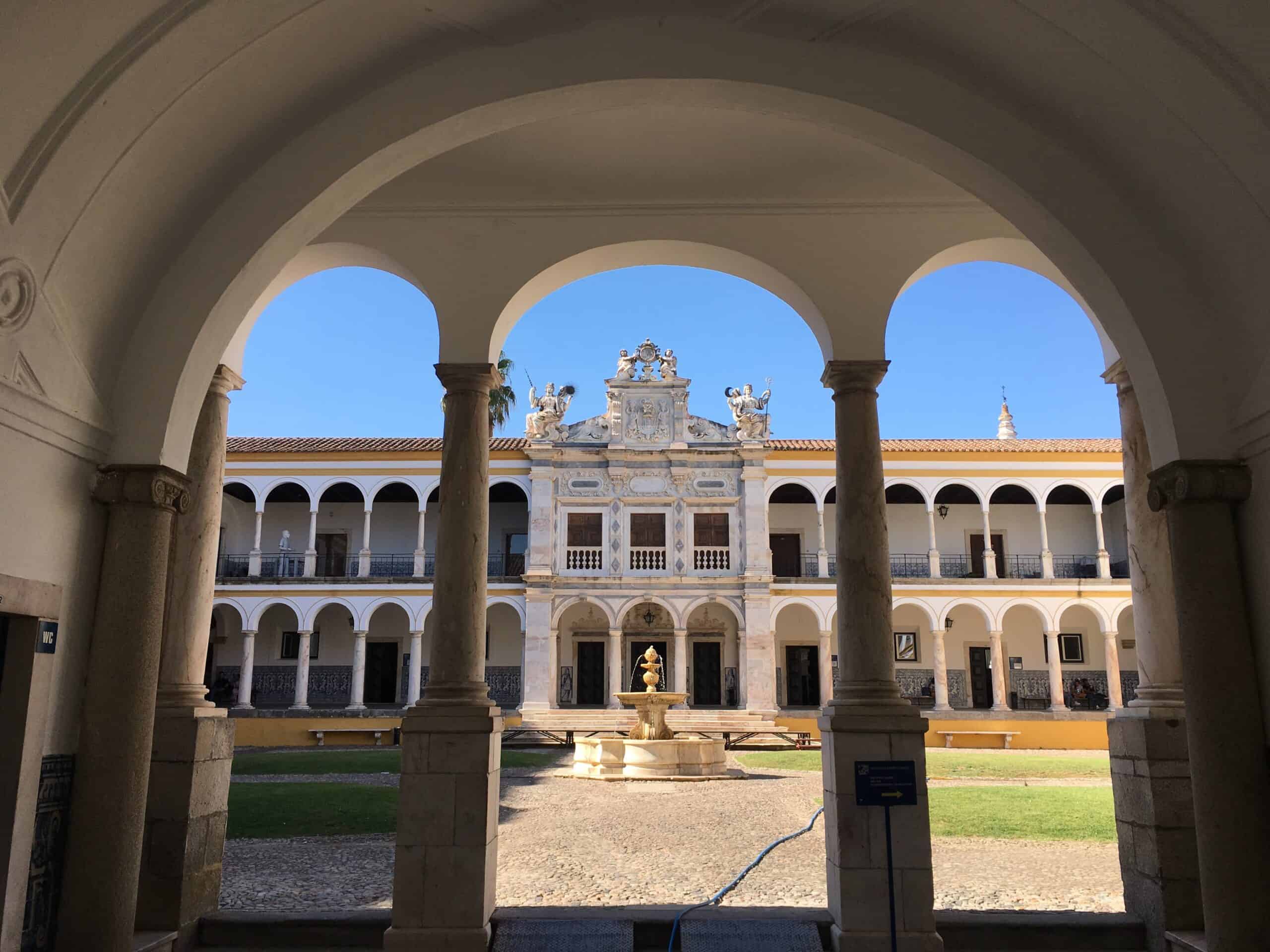 My stay began with a private tour of the city. My guide Paulo was a walking Wikipedia with his comprehensive knowledge of the Evora’s complex history. He brought the city to life, casually pointing out the interesting details that I’d otherwise have easily missed: from the impressively study and strong Roman walls which are neatly abutted by the more recent, now crumbling medieval constructions, to the stout stone steps of the city’s Se Cathedral, where the graffiti is actually the calling card of the original masons, advertising their work.
My stay began with a private tour of the city. My guide Paulo was a walking Wikipedia with his comprehensive knowledge of the Evora’s complex history. He brought the city to life, casually pointing out the interesting details that I’d otherwise have easily missed: from the impressively study and strong Roman walls which are neatly abutted by the more recent, now crumbling medieval constructions, to the stout stone steps of the city’s Se Cathedral, where the graffiti is actually the calling card of the original masons, advertising their work.
Paulo was also keen to show me the lush renaissance-era adornments of the otherwise austere chapels and churches, the modern-day shop fronts built into the archways of the city’s ancient aqueduct, and the many architectural and cultural influences the Knights Templar, the Jewish community, and the kings of Portugal’s Royal House of Aviz have all held over Evora.
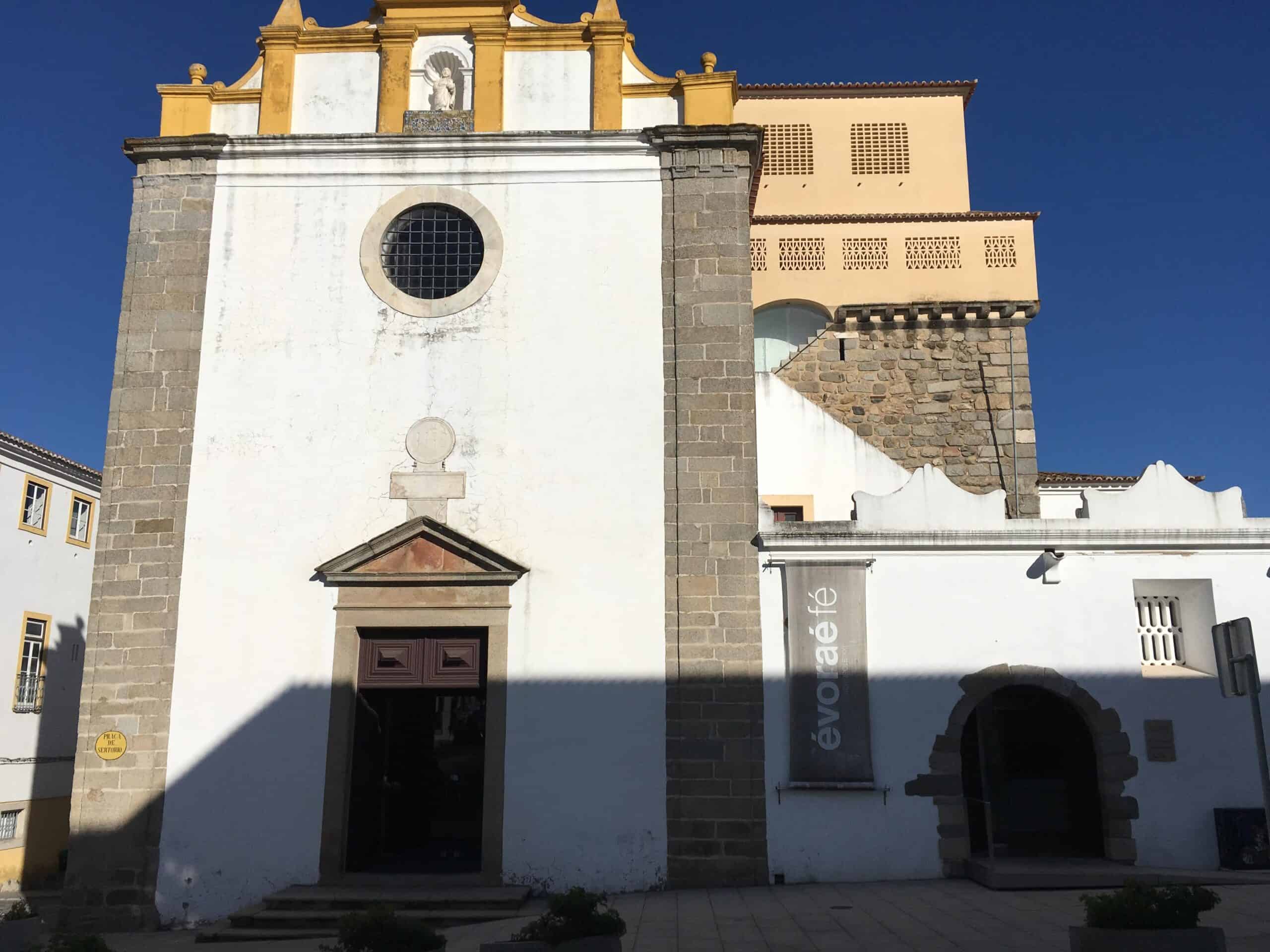
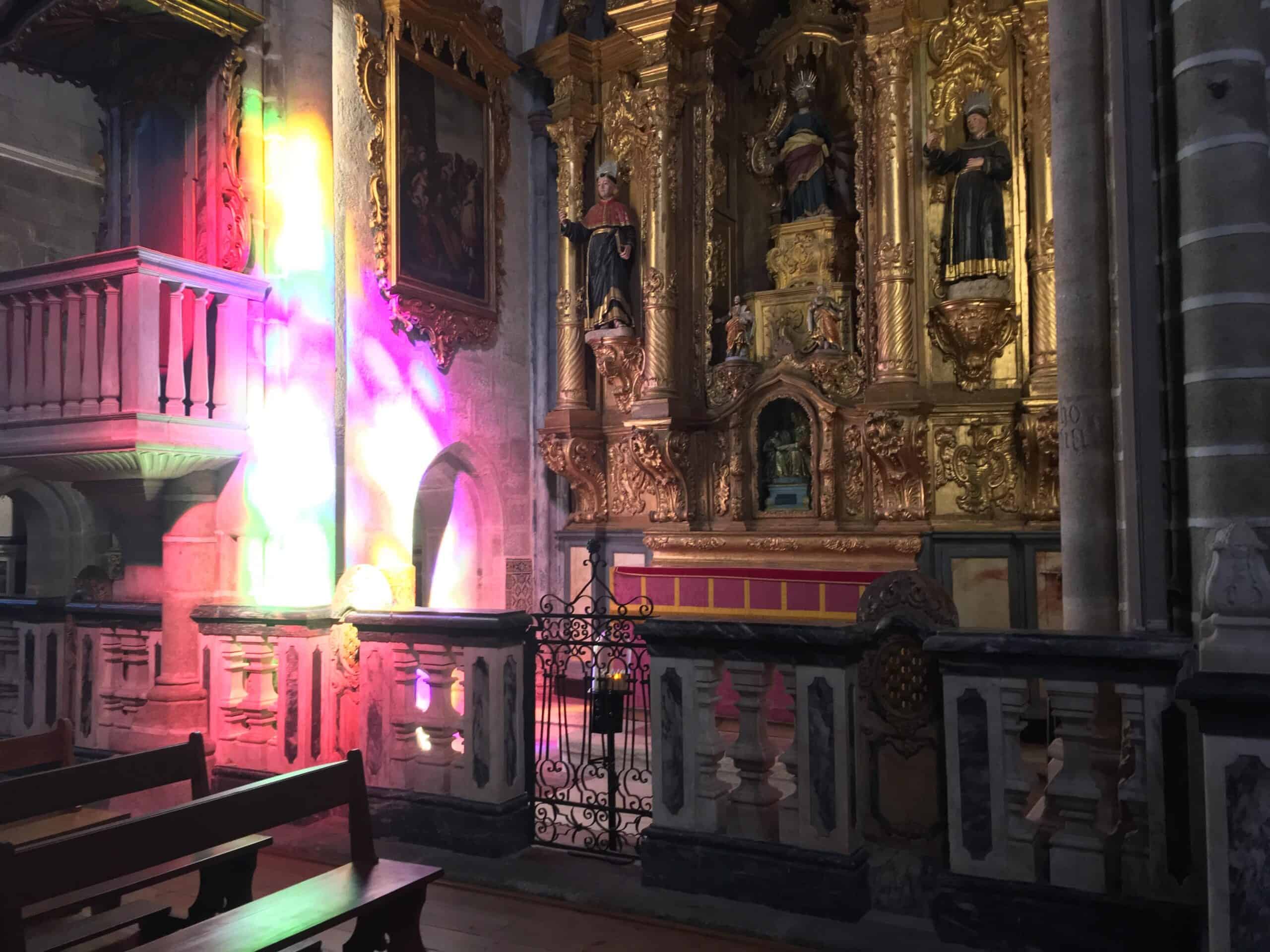 Life in Evora revolves around the grand Praca do Giraldo, and as you get lost in the rabbit warren of winding medieval streets, somehow you keep finding your way back here. The square is named in honour of the Geraldo Geraldes, who took the city from the Moors in 1167. Legend has it: to celebrate his victory, Geraldes demolished a Roman triumphal arch which once marked the entrance to the square, and used to stone to construct the fountain which still sits at the northern end of the square.
Life in Evora revolves around the grand Praca do Giraldo, and as you get lost in the rabbit warren of winding medieval streets, somehow you keep finding your way back here. The square is named in honour of the Geraldo Geraldes, who took the city from the Moors in 1167. Legend has it: to celebrate his victory, Geraldes demolished a Roman triumphal arch which once marked the entrance to the square, and used to stone to construct the fountain which still sits at the northern end of the square.
In truth, the arch was demolished much later: during the construction of the nearby Igreja de Santo Antao church in the 15th century, as the architects felt it was ‘blocking the view’. The church itself has a small carillon – consisting of ten pitched bells which can be played using a keyboard. Sadly, the carillon doesn’t function – however, the considerably larger carillon in the national palace at Mafra was recently restored and a similar restoration underway here in Evora.
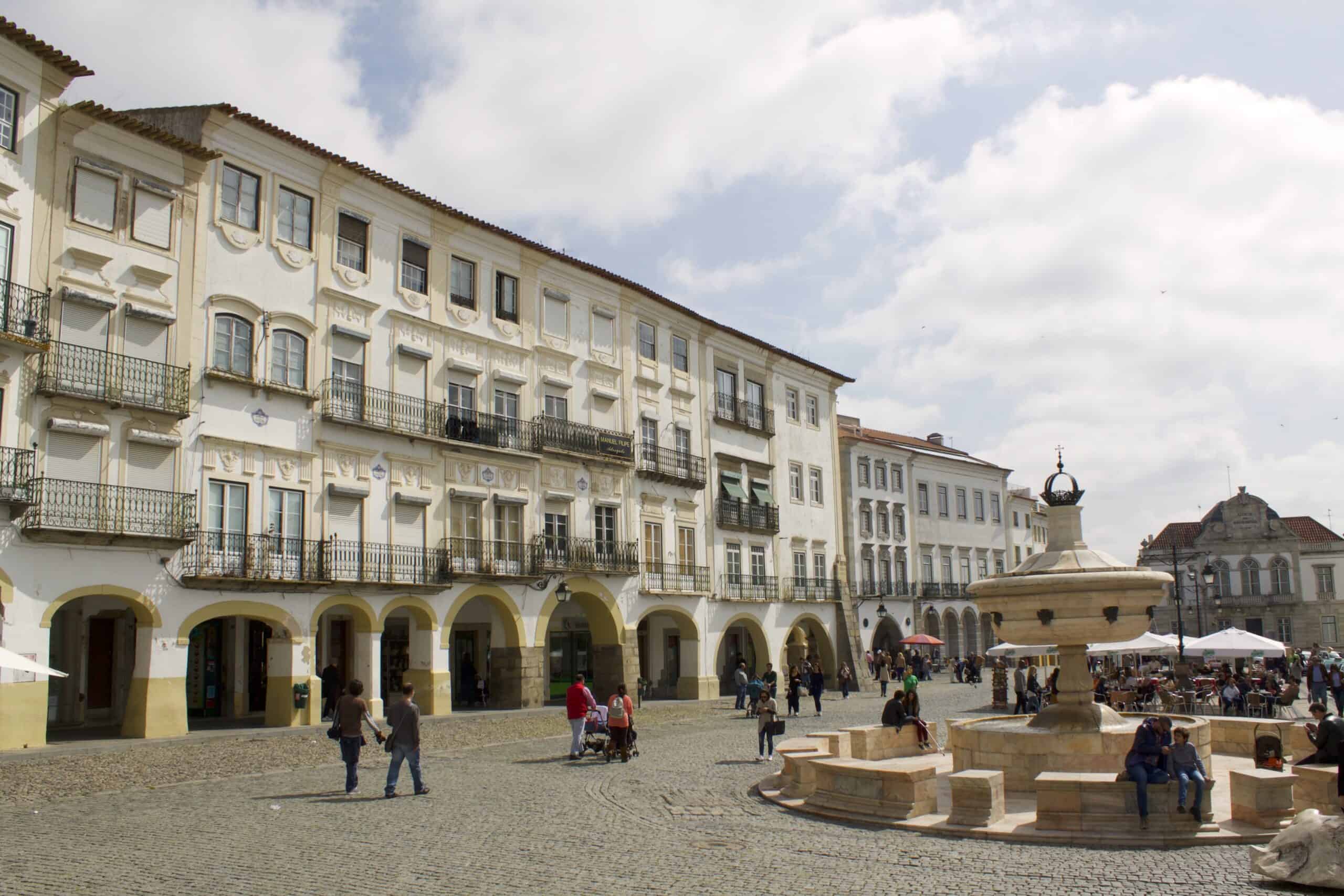
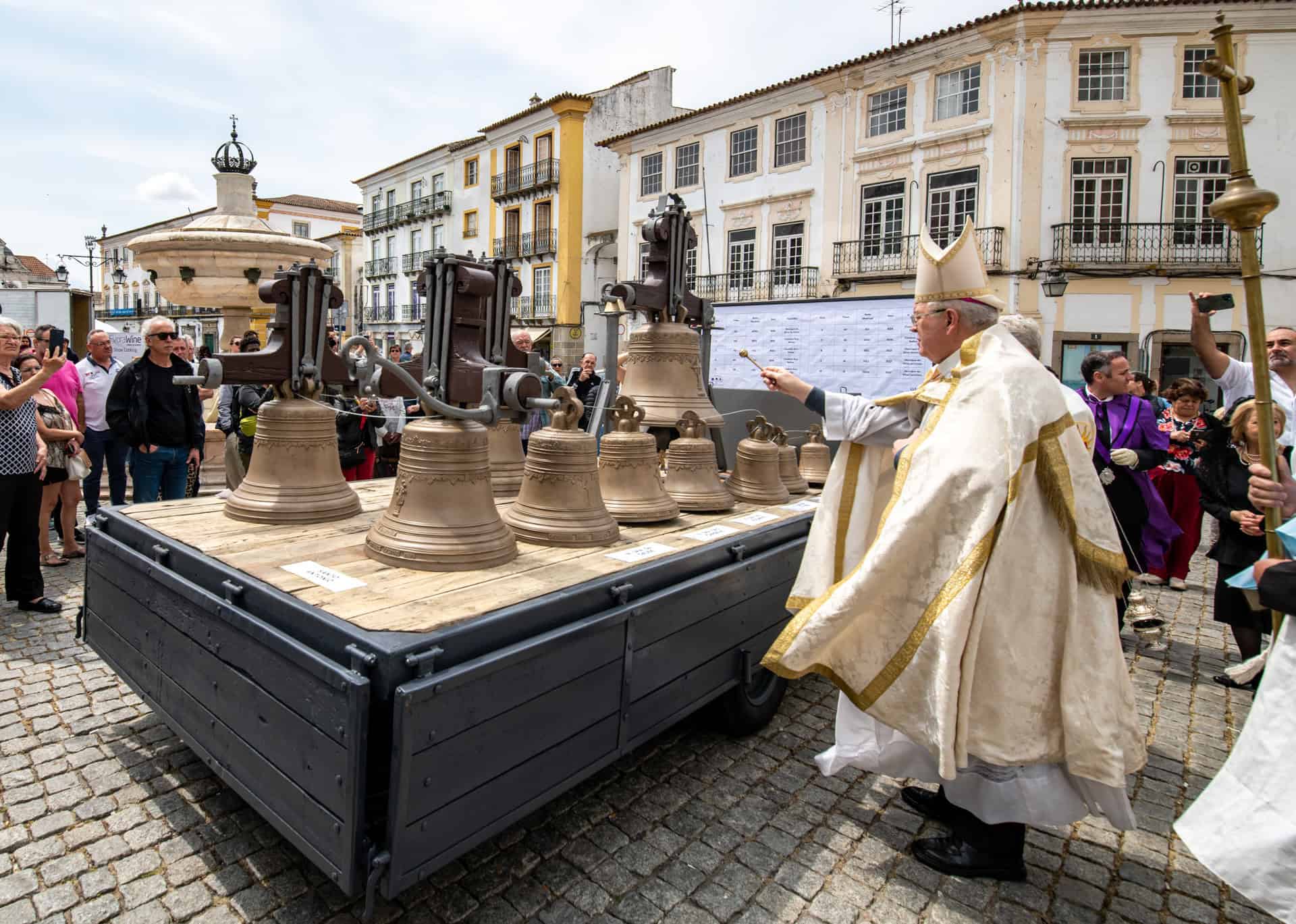 A short walk south from the square brought us to the Igreja e Mosteiro de Sao Francisco – home to the infamous Capela dos Ossos: the Chapel of Bones, whose walls and vaulted ceilings are decorated with 5000 human skeletons.
A short walk south from the square brought us to the Igreja e Mosteiro de Sao Francisco – home to the infamous Capela dos Ossos: the Chapel of Bones, whose walls and vaulted ceilings are decorated with 5000 human skeletons.
Evora has a long history of settlement, and so a long history of births and deaths. Bodies were buried and by the mid-16th century land available for cemeteries was becoming scarce. The monks macabre solution was to relocate the bones to a chapel so as not to condemn the souls of the dead. Instead of hiding the bones, the monks set them into the interior walls of the chapel, thus creating a place to contemplate the transience of existence.
The inscription above the door reads Nos ossos que aqui estamos pelos vossos esperamos: “We bones that are here, await yours”. The fact that the monks created patterns with the bones, mixing up bodies, only adds to the feeling of transience experienced in the chapel.
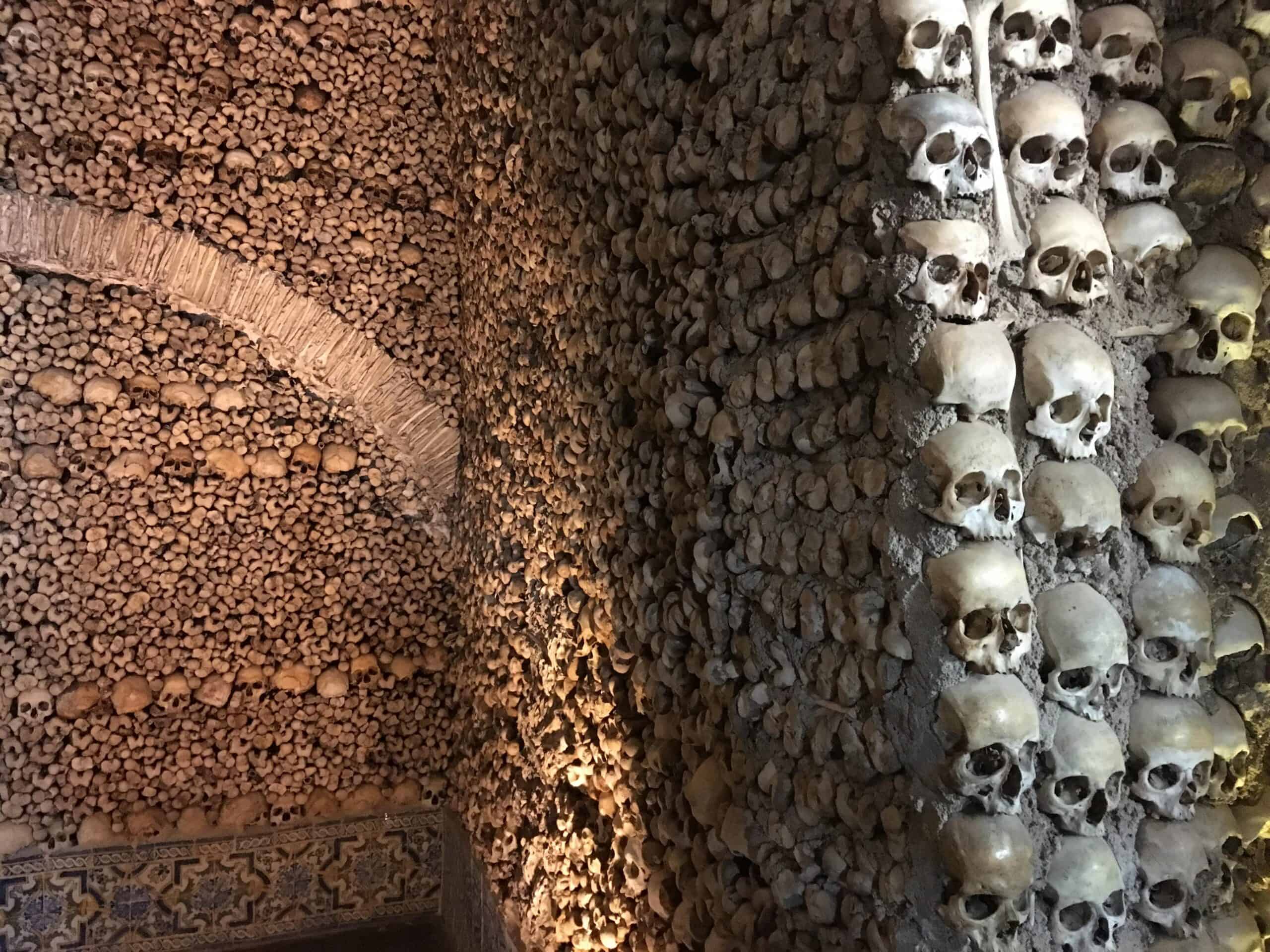
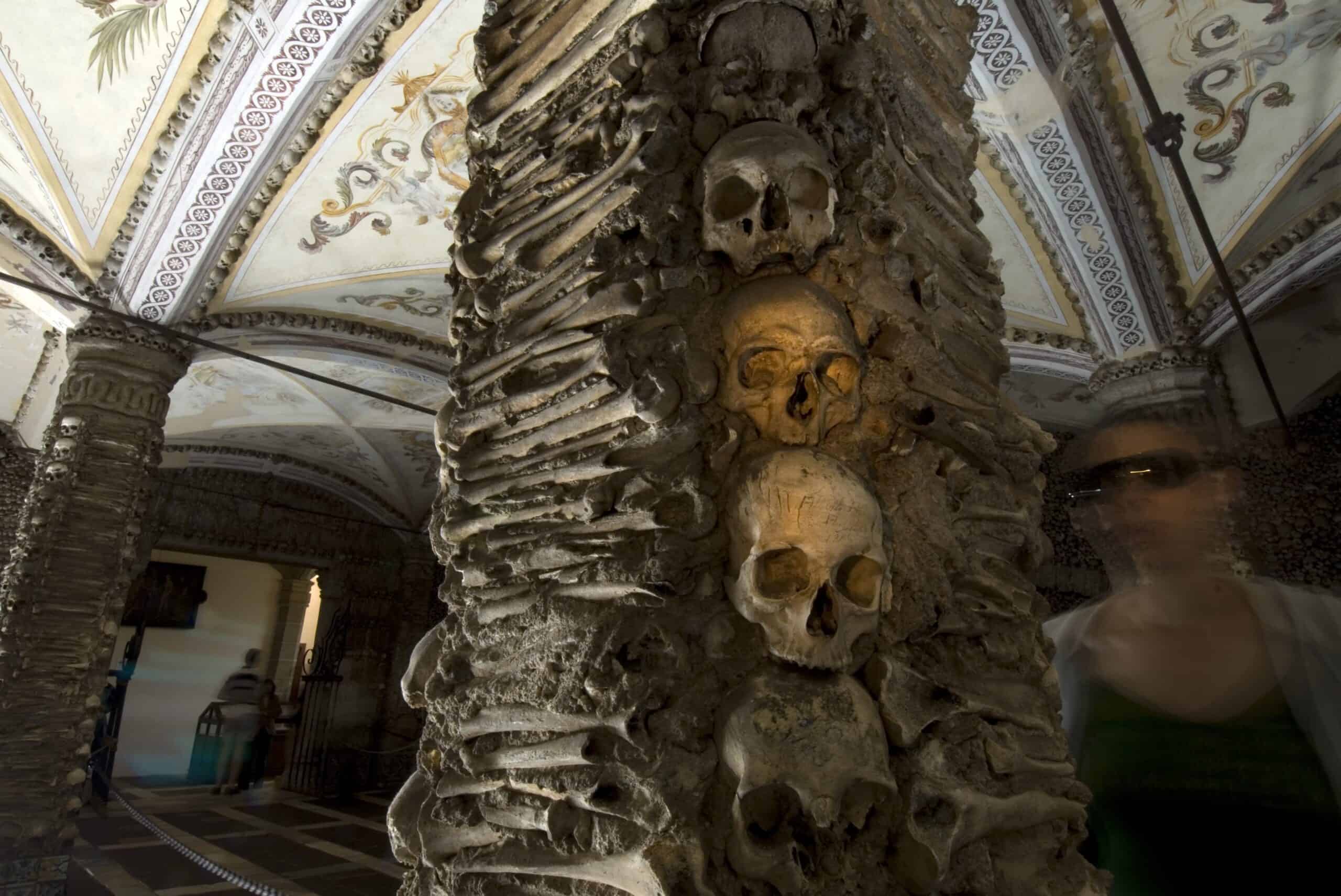
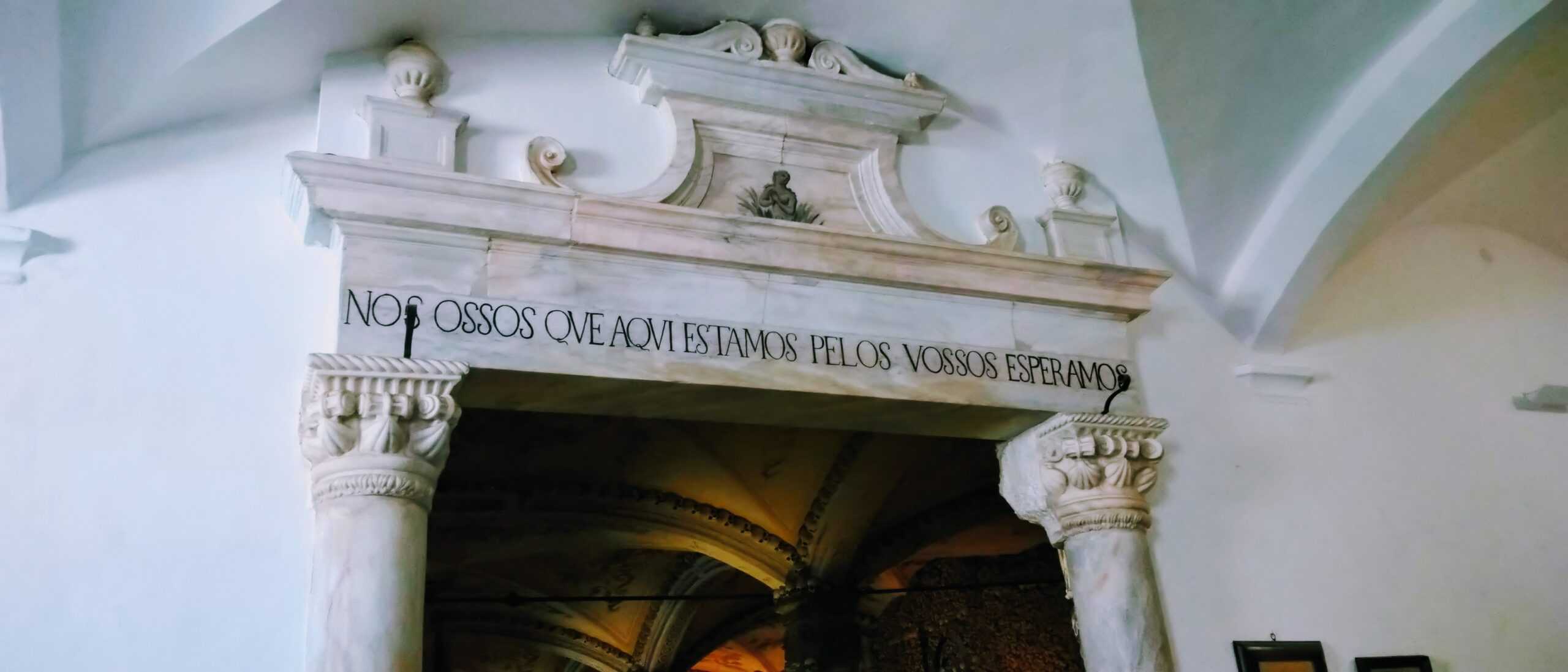 Our next stop was the Se de Evora Cathedral. A modest chapel was first constructed here in celebration of Geraldes’ victory in 1167, with gothic cloisters added in the 14th century, a Manueline chapel in the 16th century and the baroque main chapel in the 18th century. Prior to his pioneering voyage from Portugal to India, it’s said that Vasco da Gama’s flags were blessed here before they made their way to Montemor-o-Novo to receive a second blessing from the king.
Our next stop was the Se de Evora Cathedral. A modest chapel was first constructed here in celebration of Geraldes’ victory in 1167, with gothic cloisters added in the 14th century, a Manueline chapel in the 16th century and the baroque main chapel in the 18th century. Prior to his pioneering voyage from Portugal to India, it’s said that Vasco da Gama’s flags were blessed here before they made their way to Montemor-o-Novo to receive a second blessing from the king.
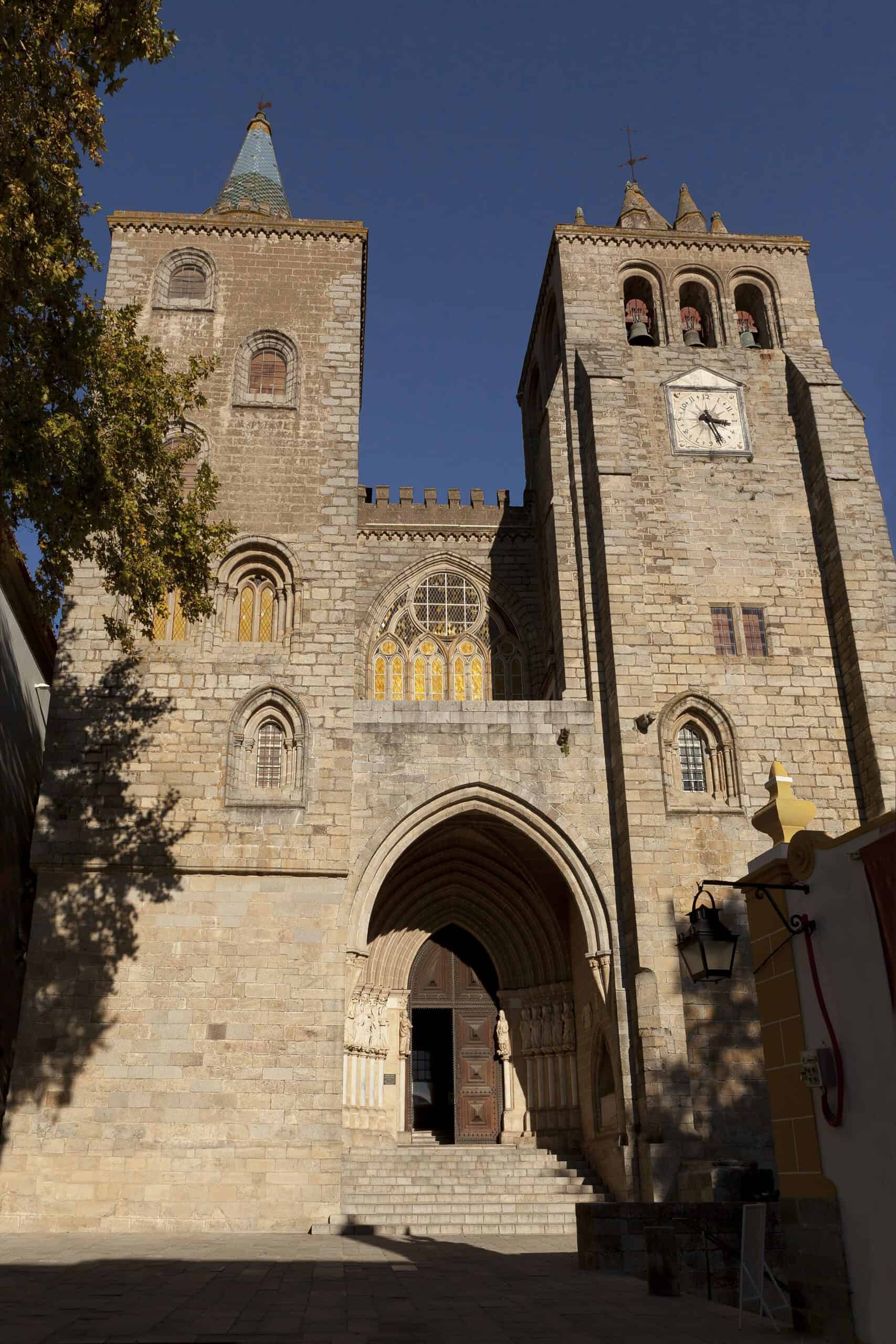
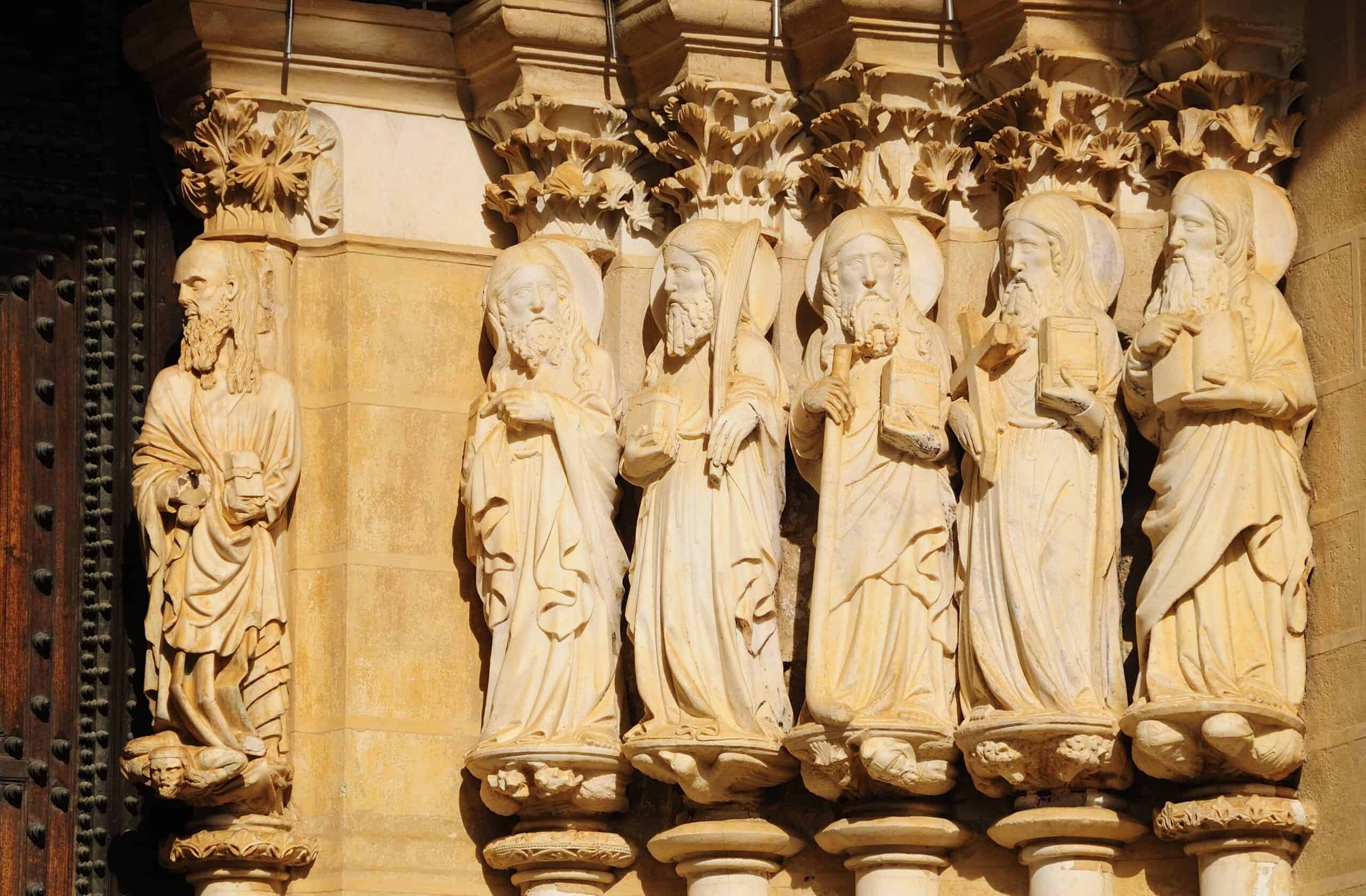 One of Portugal’s most-famous Roman landmarks is close by: the Templo Romano de Evora. Known colloquially as Diana’s Temple, it was constructed in 1st century and was part of the main forum of Roman Evora. With the fall of Rome, the temple was abandoned for ten centuries until the structure was incorporated into Dom Alfonso V’s plans to fortify Evora. These medieval extensions to the temple remained right up until the mid-1800s, when a program of restoration detached the original Roman structure from the nearby Palacio da Inquisicao.
One of Portugal’s most-famous Roman landmarks is close by: the Templo Romano de Evora. Known colloquially as Diana’s Temple, it was constructed in 1st century and was part of the main forum of Roman Evora. With the fall of Rome, the temple was abandoned for ten centuries until the structure was incorporated into Dom Alfonso V’s plans to fortify Evora. These medieval extensions to the temple remained right up until the mid-1800s, when a program of restoration detached the original Roman structure from the nearby Palacio da Inquisicao.
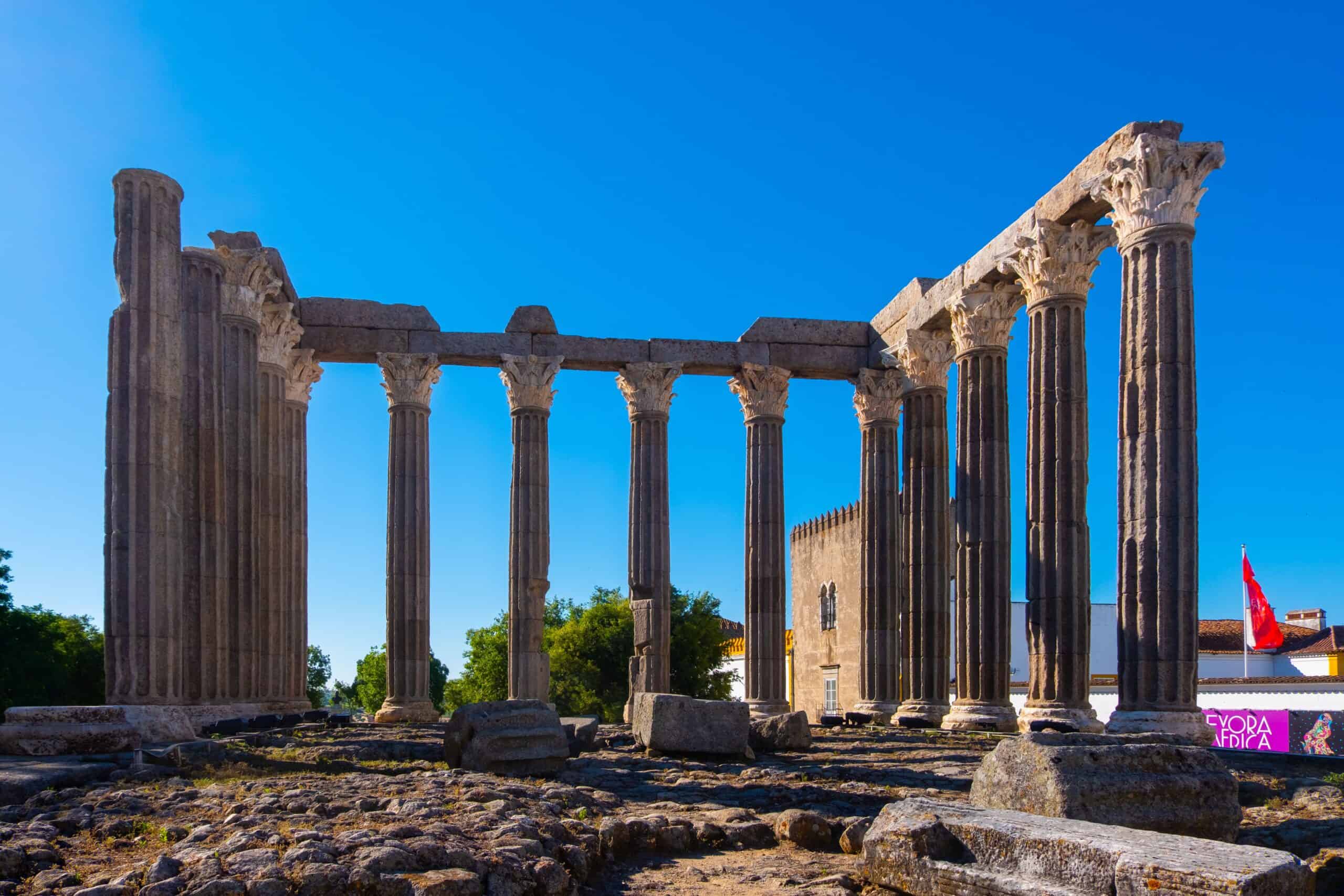
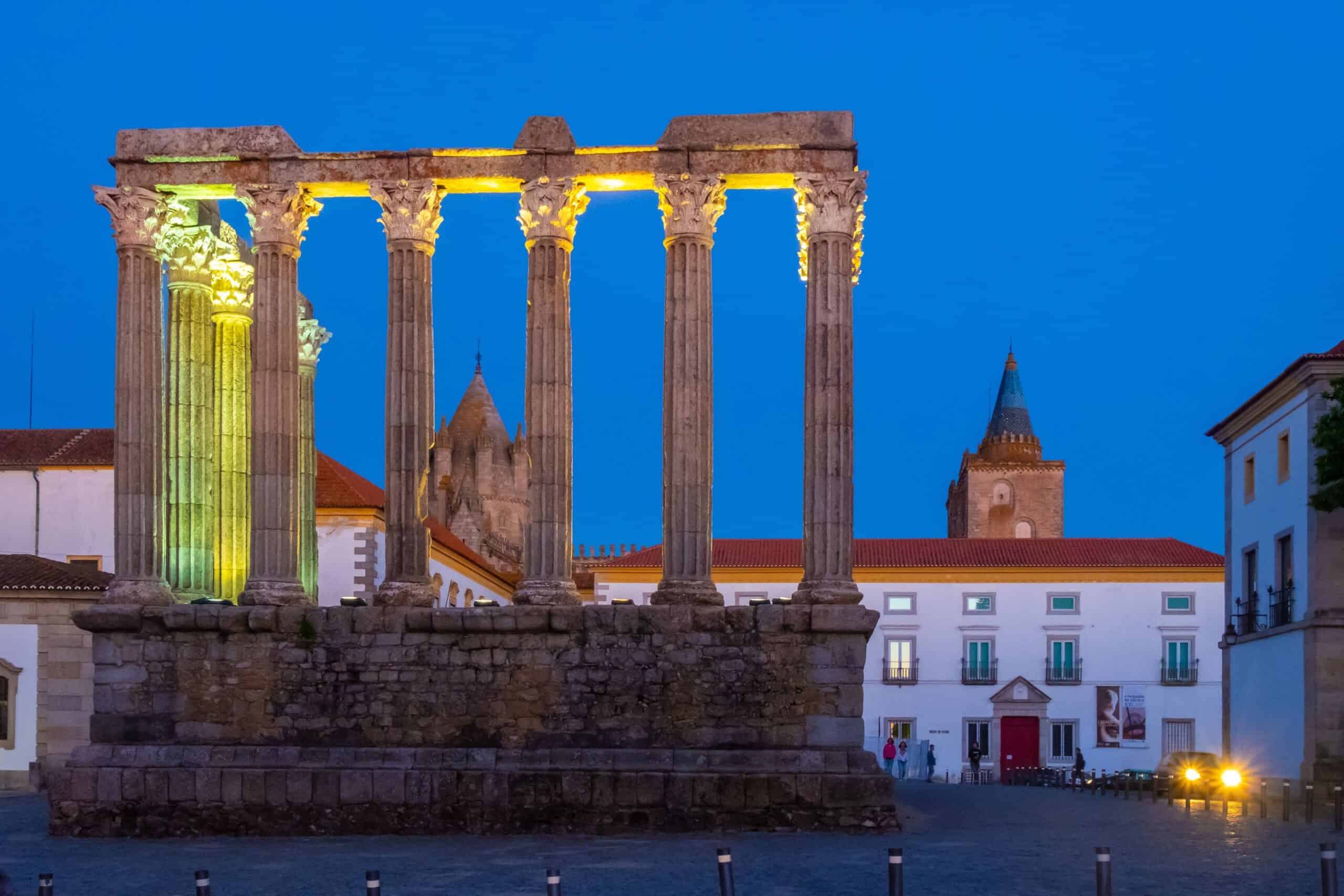 Our final stop of the day was at the Ervideira Wine Shop. Alentejo has a rich history of wine making dating back to Roman times, and Paulo talked me through the best of the region’s wines. The 117-hectare Ervideira vineyards in the nearby towns of Vidigueira and Reguengos de Monsaraz are overseen by the fifth generation of the Leal da Costa family. Their speciality is Invisivel: a unique ‘invisible’ wine, made from peeled Aragonez red grapes, which are native to Alentejo and produce a clear wine.
Our final stop of the day was at the Ervideira Wine Shop. Alentejo has a rich history of wine making dating back to Roman times, and Paulo talked me through the best of the region’s wines. The 117-hectare Ervideira vineyards in the nearby towns of Vidigueira and Reguengos de Monsaraz are overseen by the fifth generation of the Leal da Costa family. Their speciality is Invisivel: a unique ‘invisible’ wine, made from peeled Aragonez red grapes, which are native to Alentejo and produce a clear wine.
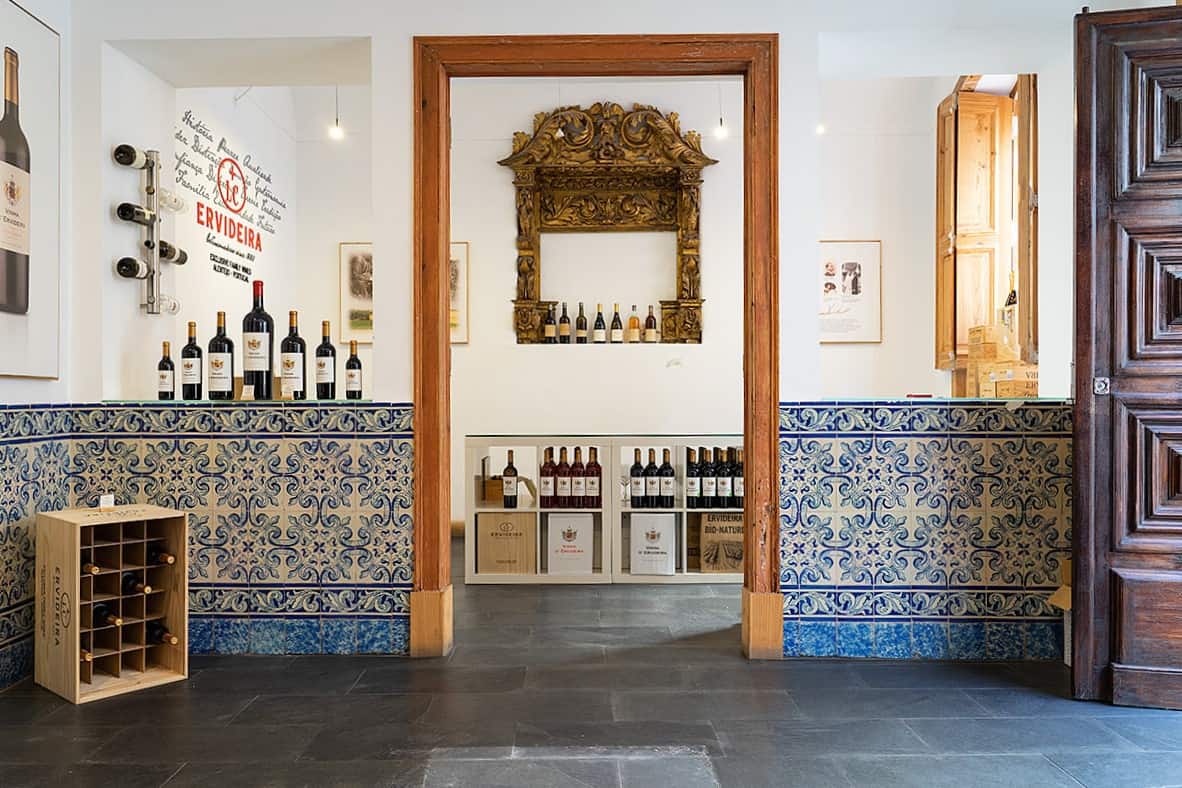
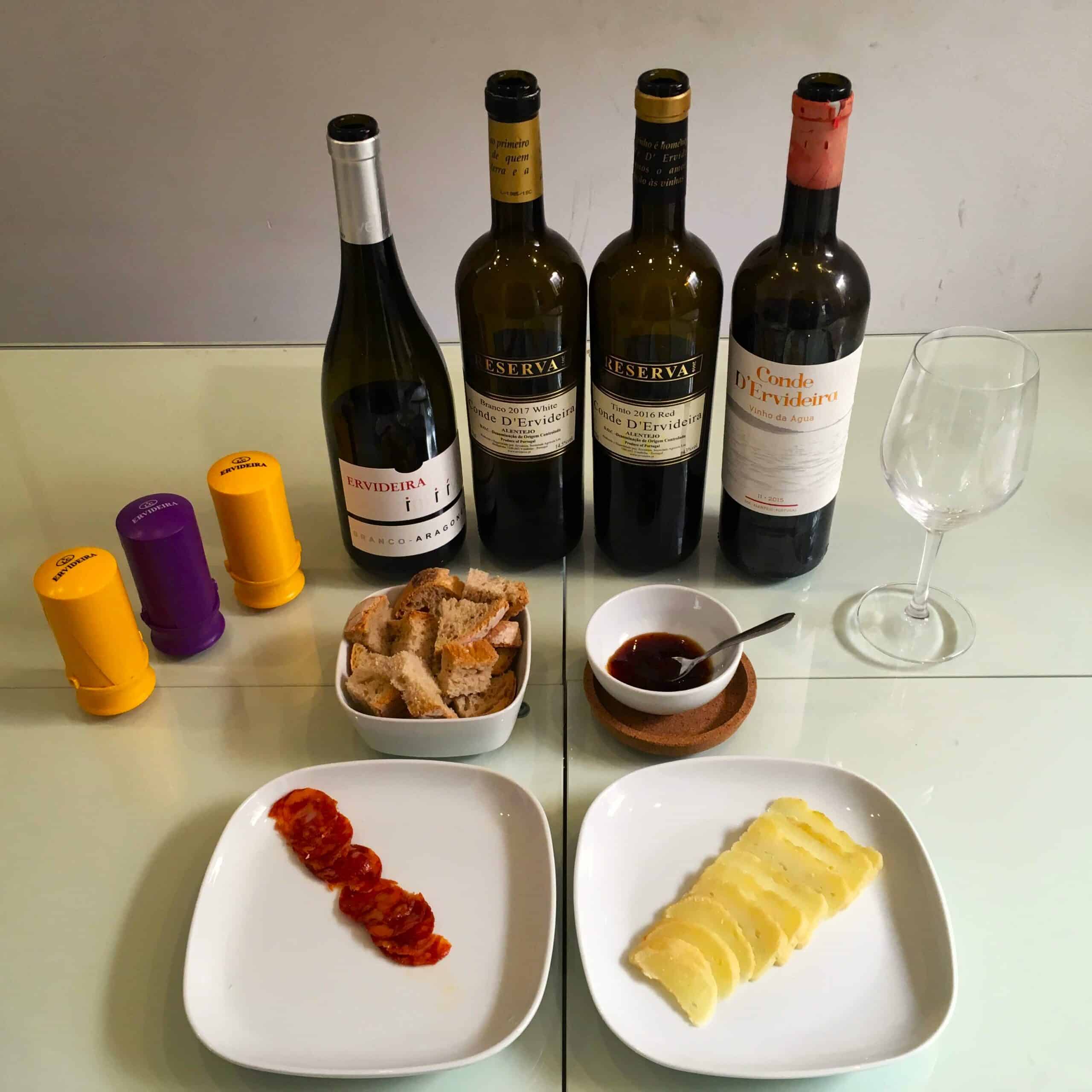 50% of the world’s wine bottle corks come from the forests around Evora. Cork is an incredibly sustainable product – the Sobreiro oak tree isn’t felled when the cork is harvested and the average lifespan of the trees is around two hundred and fifty years. As cork is waterproof and stronger than leather, Evora’s tourist shops are filled with cork wallets, cork hats, waistcoats, postcards – pretty much anything you can think of, made from cork.
50% of the world’s wine bottle corks come from the forests around Evora. Cork is an incredibly sustainable product – the Sobreiro oak tree isn’t felled when the cork is harvested and the average lifespan of the trees is around two hundred and fifty years. As cork is waterproof and stronger than leather, Evora’s tourist shops are filled with cork wallets, cork hats, waistcoats, postcards – pretty much anything you can think of, made from cork.
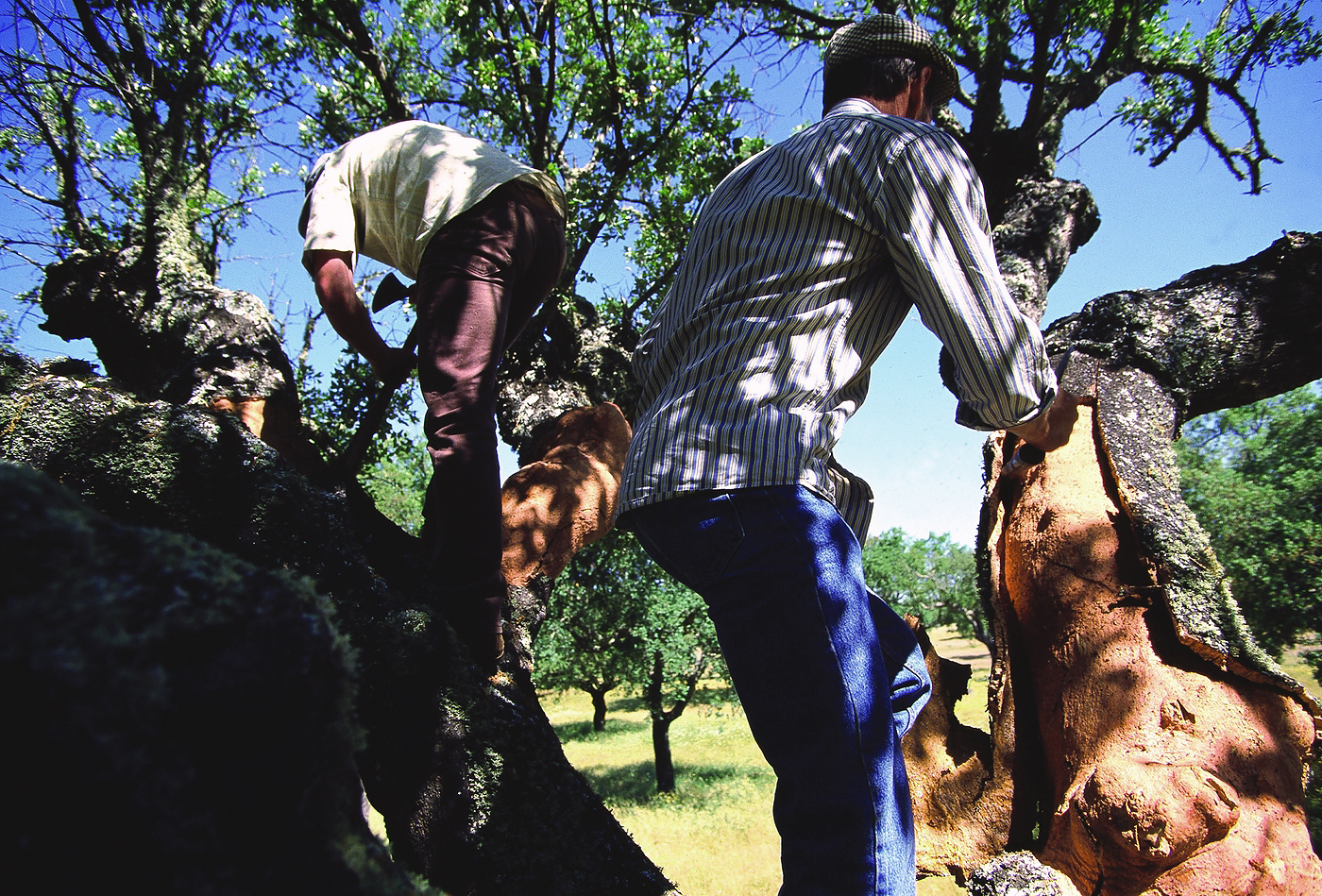
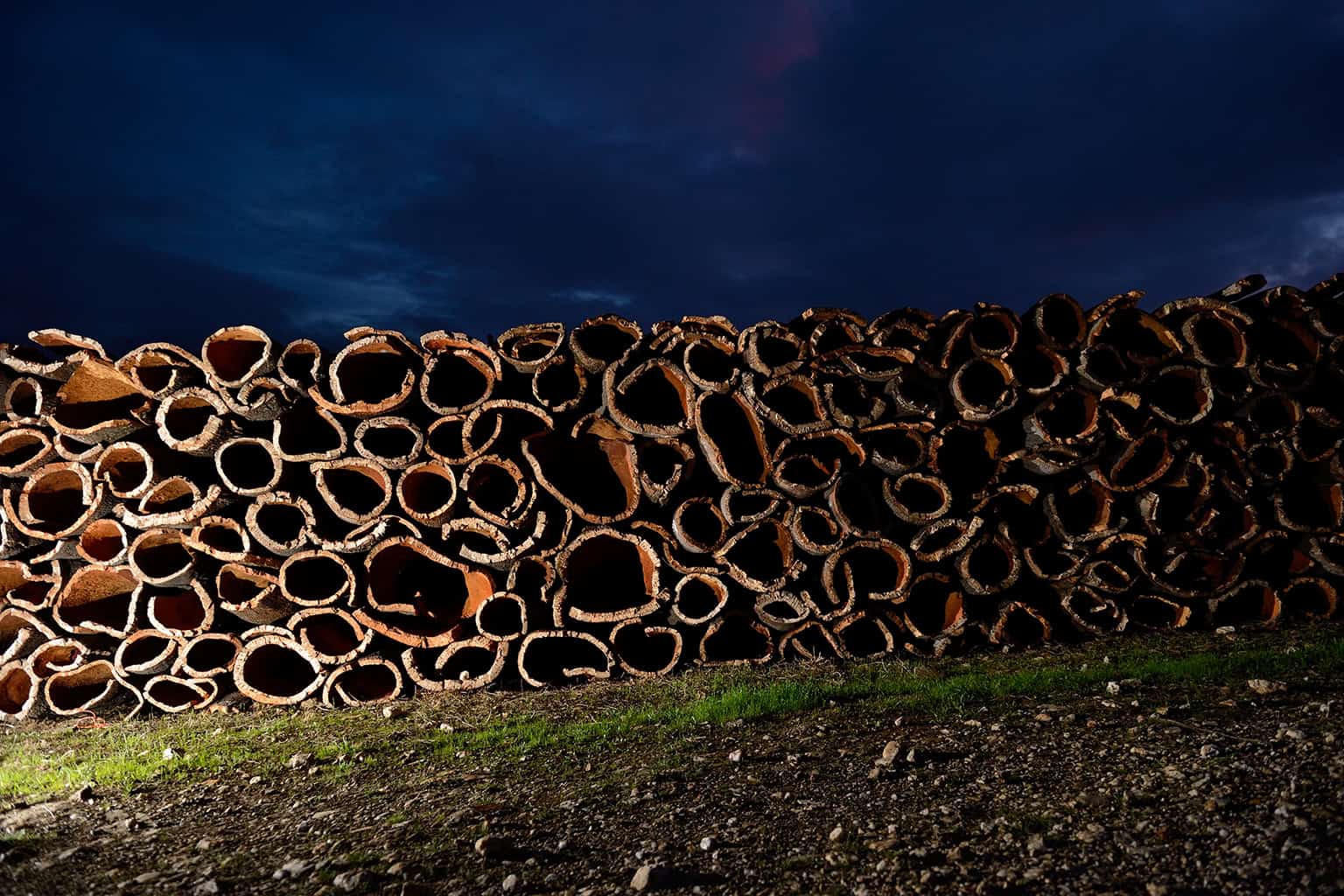
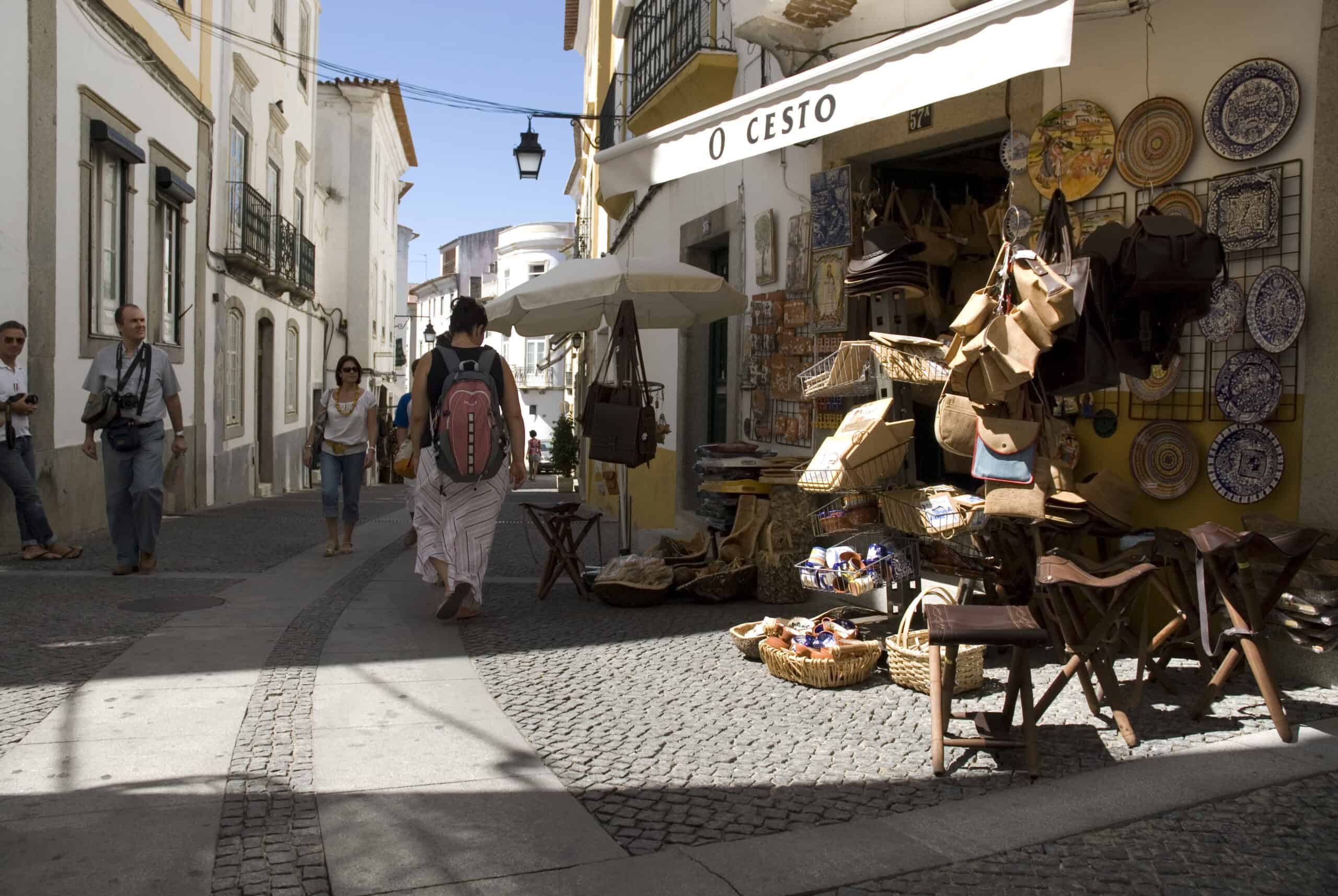 In keeping with the rest of the city, Evora has a wonderful range of hotels which mix the old with the new, and my accommodation for the evening was the M’ar de Ar Aqueduto. It’s a stone’s throw from the Porta Velha da Lagoa, the original northern gate in the city’s medieval ramparts, and the grand Agua de Prata aqueduct, which disappeared north, off to its source in the parish of Nossa Senhora da Graca do Divor 12km away. The nearby Casa Encastradas are homes built into the archways of the aqueduct, when space within the city walls was at a premium.
In keeping with the rest of the city, Evora has a wonderful range of hotels which mix the old with the new, and my accommodation for the evening was the M’ar de Ar Aqueduto. It’s a stone’s throw from the Porta Velha da Lagoa, the original northern gate in the city’s medieval ramparts, and the grand Agua de Prata aqueduct, which disappeared north, off to its source in the parish of Nossa Senhora da Graca do Divor 12km away. The nearby Casa Encastradas are homes built into the archways of the aqueduct, when space within the city walls was at a premium.
The M’ar de Ar Aqueduto has lovely large rooms, a quiet garden, a pool and spa, a relaxing bar for your evenings and an amazing breakfast to start your day. Many of the rooms are in a new wing, with reception, the restaurant and the bar all situated in the older building. It all works very well together, and I’m already planning my next visit to the M’ar de Ar Aqueduto and to Evora.
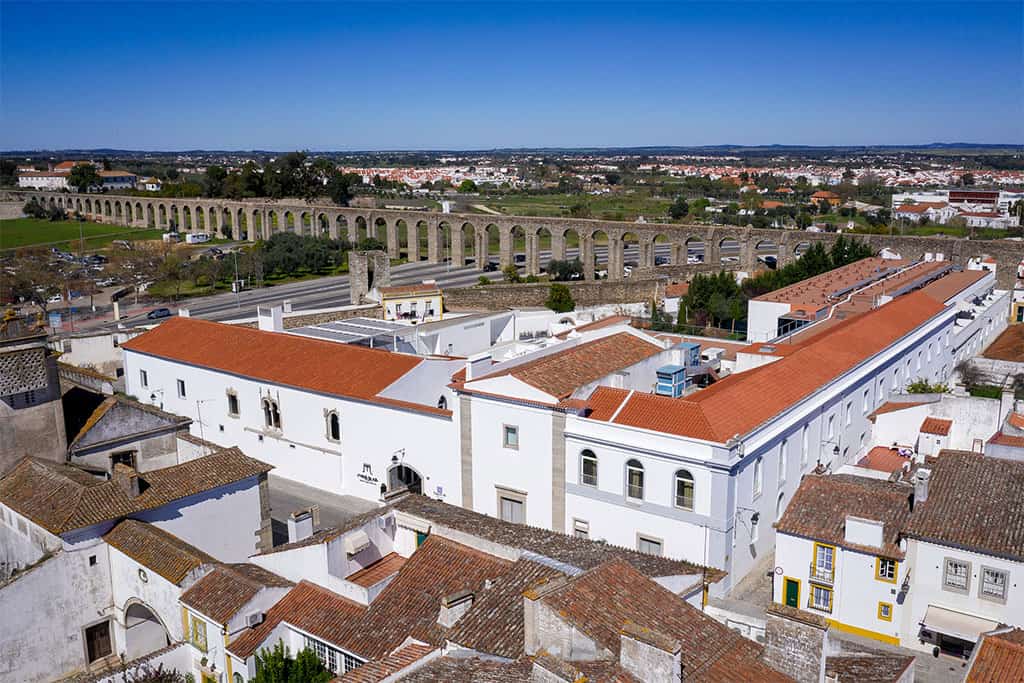
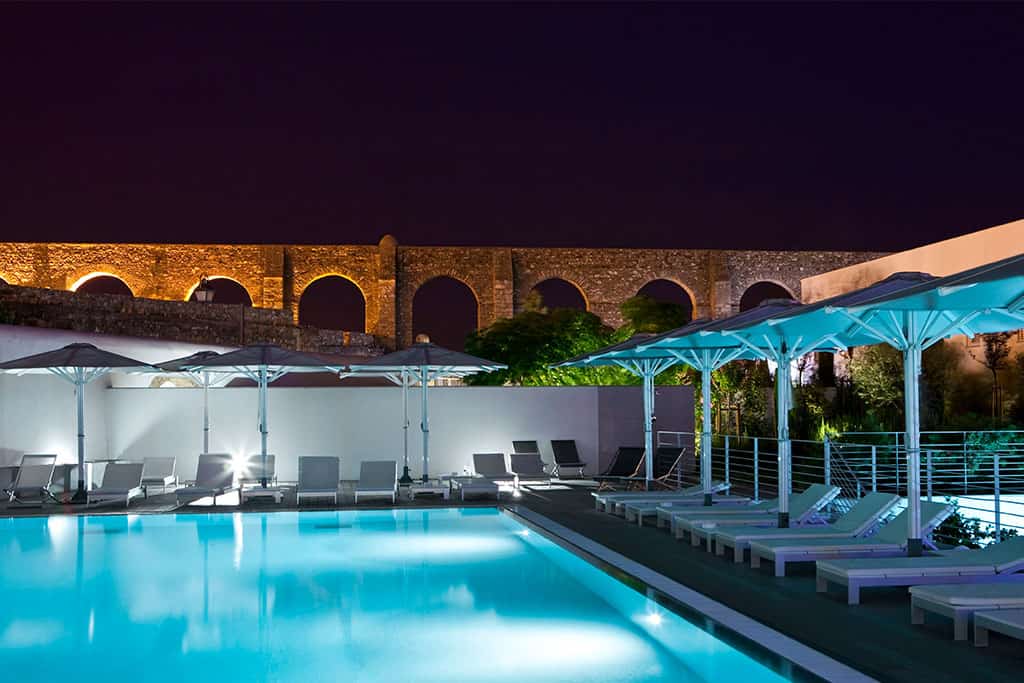
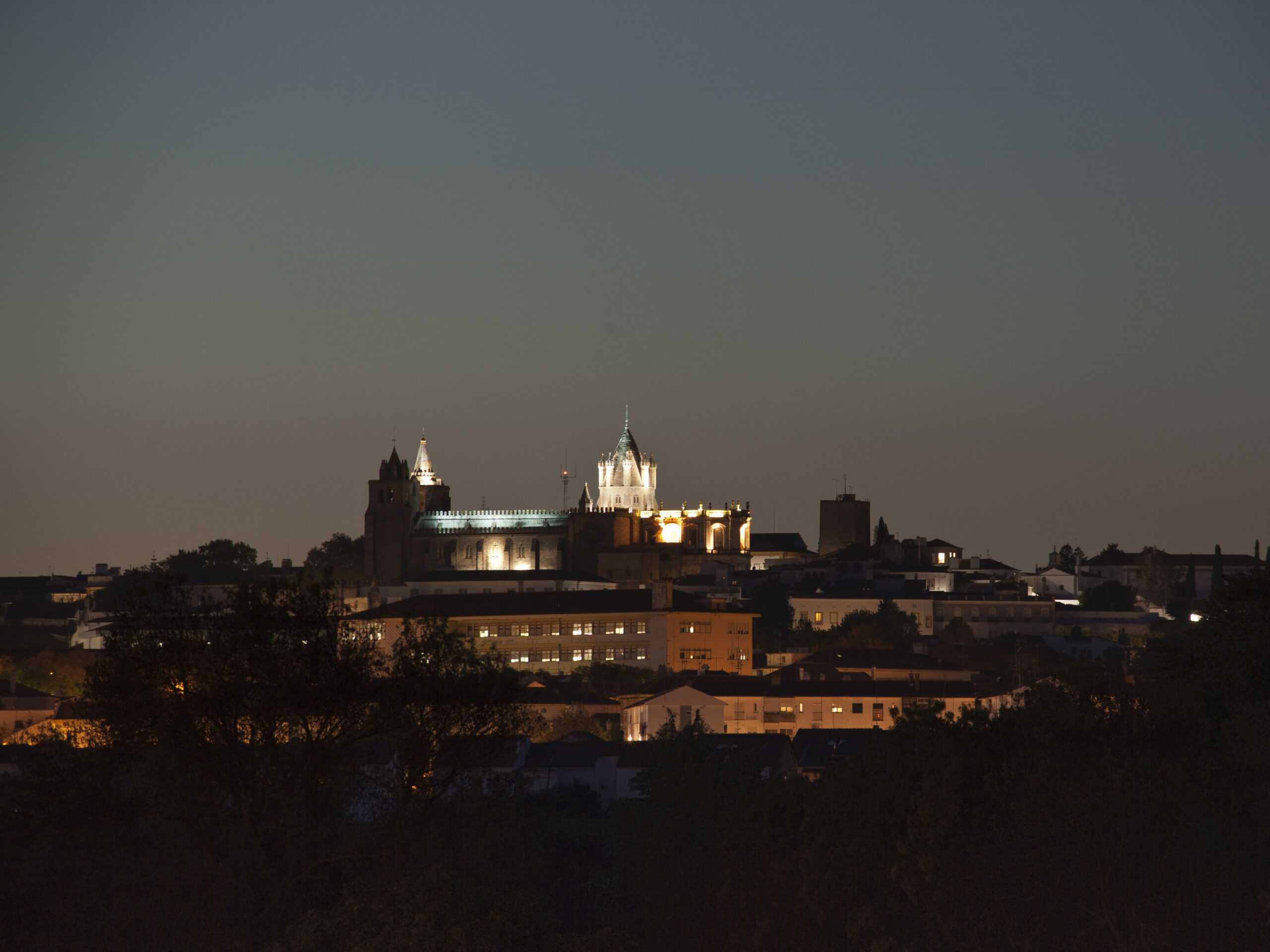
Archipelago Choice Portugal specialists
We specialise in tailor-made holidays to Portugal. Call now on 017687 721070 to begin planning your own personalised trip.








Follow us online